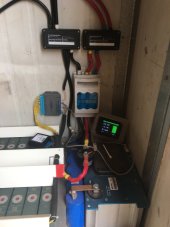You are using an out of date browser. It may not display this or other websites correctly.
You should upgrade or use an alternative browser.
You should upgrade or use an alternative browser.
A common limitation with all charge controller and AIO systems
- Thread starter coolbz
- Start date
What voltage, and did you use battery hookup capacitor they sold out awhile ago? I’m very curious about you setup. I’m thinking of building and paralleling 48v headway to solve the issue. My concern of supercapacitor is that it’s lower capacity compared to battery, so it only handles spike of a fraction of second, not longer, say 10 seconds or longer.My latest pack has a parallel supercapacitor, eliminates voltage drop under load.
Ampster
Renewable Energy Hobbyist
I am still waiting to see what the actual capacity is of that pack. We have already been told that one module has lower capacity and we know there is significant voltage sag at 0.2C. My hypothesis is that the pack has a lower capacity than 5kWh. It would be informative to test that hypothesis. The title of the thread is a distraction from finding out what the actual issue is. I am constantly reminded in problem solving issues around my home to test my assumptions. So far the capacity of the pack is only an assumption.
I don’t think the total kWh battery capacity is any issue. One pack does have a little lower capacity so I do not push charging to limit. The battery ohms and AIO volt settings combined is the main issue.I am still waiting to see what the actual capacity is of that pack. We have already been told that one module has lower capacity and we know there is significant voltage sag at 0.2C. My hypothesis is that the pack has a lower capacity than 5kWh. It would be informative to test that hypothesis. The title of the thread is a distraction from finding out what the actual issue is. I am constantly reminded in problem solving issues around my home to test my assumptions. So far the capacity of the pack is only an assumption.
My settings have been conservative so it never tried to 100% charge. From AIO, I can tell it easily charge 4.5.kWh from grid so battery voltage rise from 50v to 54.5. Many people here tried to charge to 56v, if I do it’s going over 5kwh no problem. Again, my main concern is not battery capacity. Capacity being 5kwh or 4kwh does not change the fact of ohms or volt numbers I measured and calculated, right?
Ampster
Renewable Energy Hobbyist
I completely understand your belief in the capacity you purchased. However, capacity does remain as the only untested assumption in these multiple pages of discussion across two topics. When my Nissan Leaf modules began exhibiting loss of capacity they also showed inconsistent internal resistance. Do all your modules show the same IR?I don’t think the total kWh battery capacity is any issue.
What voltage, and did you use battery hookup capacitor they sold out awhile ago? I’m very curious about you setup. I’m thinking of building and paralleling 48v headway to solve the issue. My concern of supercapacitor is that it’s lower capacity compared to battery, so it only handles spike of a fraction of second, not longer, say 10 seconds or longer.
It is a 64V maxwell supercap. It will cover motor start surges that last a few seconds.
I bought it in Australia.
Attachments
Bud Martin
Solar Wizard
- Joined
- Aug 27, 2020
- Messages
- 4,843
How many Farad is that? Do you have manual pre-charge?
400bird
Solar Wizard
What is under to the taped series connections?
What gauge is your wiring? The wires look plenty large enough for 20 amps without any issues.
What gauge is your wiring? The wires look plenty large enough for 20 amps without any issues.
Ampster
Renewable Energy Hobbyist
If I wanted to understand what was going on, I would load up that pack with 2 or 3 kWs and measure individual cell voltages. The title of this thread may be a red herring. Clearly the issue is voltage sag. Whether that is a result of the pack or something else remains to be seen. A $20 Amazon current sensor and cell voltages at various current draws would answer a lot of questions.
How many Farad is that? Do you have manual pre-charge?
It is a 125F capacitor (4x12V/500F in series)
I manually precharge before initial connection. There is a slow blow 160A NH00 fuse between the supercap and loads/battery.
What is under to the taped series connections?
What gauge is your wiring? The wires look plenty large enough for 20 amps without any issues.
The cells are connected by plated copper busbars, the wiring is 50mm2. This system doesn’t see over 150a.
400bird
Solar Wizard
Looks great!The cells are connected by plated copper busbars, the wiring is 50mm2. This system doesn’t see over 150a.
I was asking the OP. He posted a pic in post 42.
Ampster
Renewable Energy Hobbyist
Similar threads
- Replies
- 3
- Views
- 199
- Replies
- 87
- Views
- 2K
- Replies
- 12
- Views
- 409
- Replies
- 2
- Views
- 281




